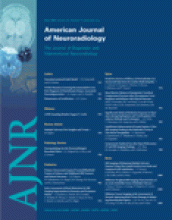Abstract
BACKGROUND AND PURPOSE: Elastase-induced aneurysms in rabbits have become an accepted model to study endovascular treatment. The size and shape of the resulting aneurysms may vary widely. Our goal was to predict the final aneurysm morphology on the basis of immediate postinduction geometry.
METHODS: Thirty New Zealand white rabbits were used. Aneurysms were created at the origin of the right common carotid artery (CCA). Intraluminal incubation of elastase was applied to the origin of CCA with proximal balloon occlusion of the artery. The aneurysms were allowed to mature for 3 weeks and evaluated by digital subtraction angiography. We retrospectively measured neck diameter, dome height, and aneurysm diameter, as well as the angle between the parent artery and the main axis of the aneurysm neck. We performed correlation analysis with immediate postinduction geometry.
RESULTS: The diameter of the origin of the CCA measured immediately after elastase incubation correlated positively to the mature aneurysm neck (P < .01). Moreover, the aneurysm neck both after the aneurysm creation and at 3-week follow-up had a positive correlation with the final dome height (P < .05). Finally, the dome height was related to the angle between the centerline of the innominate artery and axis of the aneurysm neck for dome diameter-to-neck ratio of <1.5 (P < .05).
CONCLUSION: These results indicate that neck width immediately after creation and the curvature of the parent artery are linked to the final aneurysm dimensions, and we may be able to predict the size of aneurysm on the day of creation.
- Copyright © American Society of Neuroradiology












